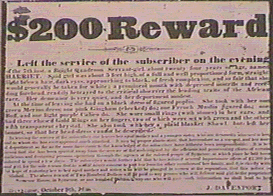Harriet Powell's Escape from Slavery
 "Public
sentiment was at white heat on the question." So said feminist Elizabeth
Cady Stanton, in her autobiography, discussing the events of October 1839. The
question was slavery, as only a few weeks had passed since the capture in New
England of the slave ship Amistad.
"Public
sentiment was at white heat on the question." So said feminist Elizabeth
Cady Stanton, in her autobiography, discussing the events of October 1839. The
question was slavery, as only a few weeks had passed since the capture in New
England of the slave ship Amistad.
Madison County hosted a month-long series of anti-slavery conventions that
October, where Elizabeth Cady met her husband to be, abolitionist Henry Stanton.
There she also met Harriet Powell, whose escape from slavery in downtown
Syracuse helped to establish this area's reputation as a national center of
anti-slavery action.
Harriet Powell came to Syracuse around October 1, 1839, as a servant to a
wealthy couple visiting from Mississippi. Originally from Onondaga County, the
Davenport's were the toast of the town in Syracuse high society. They were also
the subject of intense discussion as it became known their young companion was
not a member of the family, as many had first assumed.
As word spread that the beautiful young woman was held in slavery by the
couple, plans were quickly made to offer her liberty. She was approached by
African American employees of the Syracuse House, the downtown hotel (now the
site of OnBank) where the family was staying. Harriet made up her mind to risk
escape, knowing she'd never again see her mother and sister, who were also held
in slavery by the Davenports.
On October 7, Harriet placed the Davenports' child in the arms of its mother
and walked out the back door of the home where their farewell celebration was
being held. There she was met by one of the several African American citizens
of Syracuse who aided in her escape. Others had made arrangements to remove her
possessions from the Syracuse House, and to have a carriage at the ready,
willingly supplied by a DeWitt farmer named Nottingham.
All was in order at the time of her escape, and Harriet was spirited off to
the Shepard home, a few miles south of Marcellus, where she remained for about a
week. Harriet's escape created a furor, and parties were sent out in all
directions to find her. The Davenports offered a $200 reward for her recovery (a
copy of the reward poster is on display at the Onondaga Historical Association
museum on Montgomery Street).
Just ahead of her pursuers, Harriet was taken to the home of Madison County
physician John Clarke, in the town of Lebanon. From there she was taken to the
home of Gerrit Smith, the famous abolitionist whose
Peterboro mansion was a station on the underground Railroad. It was there that
Harriet Powell met Smith's 24 year old cousin, Elizabeth Cady (Stanton).
In her autobiography, Stanton describes the two hours that she and her young
cousins spent with Harriet, learning of her life in slavery. Harriet was of one
quarter African heritage, and had been sold at auction in New Orleans at the age
of 14. Stanton described the effects of the discussion: "We all wept
together as we talked, and, when Cousin Gerrit returned to summon us away, we
needed no further education to make us earnest abolitionists."
Harriet left the Smith estate in a carriage driven by Federal Dana,one of
Smith's employees, and subsequently left Cape Vincent for Canada. Only eighteen
hours after her departure, Davenport arrived with the marshals at Smith's door.
Smith offered to allow a search of his premises, and invited Davenport to remain
for dinner, where they politely discussed the vexing problem of slavery. When
word was received that Harriet was safely in Canada, Smith published an open
letter to Davenport in the New York Tribune, telling the full story of his aid
to Harriet, and ridiculing Davenport for his professed concern for Harriet's
well being.
Davenport was reportedly so infuriated that he spent the next decade
lobbying the Congress for a stronger fugitive slave law. It was the passage of
that law that once again moved the people of Syracuse to action, when another
refugee from slavery was rescued from the custody of US Marshals on
October 1, 1851.
 "Public
sentiment was at white heat on the question." So said feminist Elizabeth
Cady Stanton, in her autobiography, discussing the events of October 1839. The
question was slavery, as only a few weeks had passed since the capture in New
England of the slave ship Amistad.
"Public
sentiment was at white heat on the question." So said feminist Elizabeth
Cady Stanton, in her autobiography, discussing the events of October 1839. The
question was slavery, as only a few weeks had passed since the capture in New
England of the slave ship Amistad.